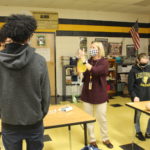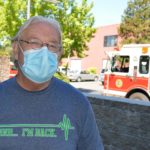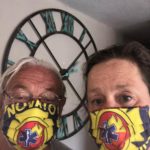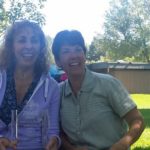
Uncategorized

Teen saves her best friend’s life with CPR a day after learning the skill in school

Azarria Simmons and Torri’ell Norwood
By Gina Mayfield
Best friends since seventh grade, Torrie Norwood, 16, and Azarria Simmons, 17, had just spent a typical Saturday night out when they decided to head home. As they drove back to their hometown of St. Petersburg, Florida, another car plowed into them. After the impact, Torrie opened her eyes and realized the car had been pushed into a tree right smack in the middle of someone’s front yard.
Then the screaming started. “It’s gonna blow!” yelled the gathering crowd as the pickup truck went up in smoke.
Torrie’s door wouldn’t open, but her window had been knocked out during the crash, so she had an obvious escape route.
“Everyone ran down the street because we all thought the car was going to blow up,” Torrie says. “But then I turned around, and I didn’t see Azarria running with us. I had to run back to the car to see if she was still in there — and she was.”
Things didn’t look good.
“She was unresponsive in the back seat,” says Torrie. “I had to drag her out because she wasn’t moving or breathing. There was glass and blood everywhere.”
That’s when the adrenaline rush kicked in.
“I don’t know how I did it, how I opened that door. It was crushed. I just became strong for a second,” she says.
That strength came in handy. In a moment of clarity amidst the chaos, Torrie instructed a bystander to call 911 and got to work.
“My focus was only on one thing. I started CPR,” Torrie says.
After 30 chest compressions and two rescue breaths, Azarria began to show signs of life. Just then, the paramedics rolled up ready to rush Azarria to the nearest hospital.
“I just kept asking them if she was going to be okay,” remembers Torrie.
Fortunately for both girls, the Athletic Lifestyle Management Academy at their Lakewood High School offers a Medical Skills class taught by longtime American Heart Association CPR Instructor Erika Miller. She teaches Basic Life Support, along with Heartsaver First Aid and Bloodborne Pathogens After CPR. Torrie had earned her certification just the day before this accident happened.
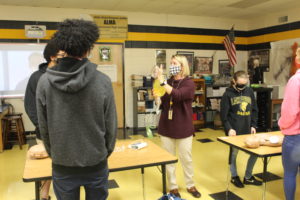
Erika Miller teaching class
“You never know when an emergency will occur,” Erika says. “In all of my years of teaching, I have never had an experience quite like this one. I never imagined a student would finish the course, take her written and skills tests and in 24 hours have to perform CPR on her best friend.”
All of the Pinellas County Schools use the AHA training tools, including 16 public high schools (three with medical magnet student programs), and offer training for bus drivers, coaches and staff.
“I tell my students that it is one thing to know life-saving skills, but it’s another thing to be comfortable helping in an emergency,” Erika said. “At the end of the day, I want my students to not only know what to do, but to be willing and able to help, if needed.”
Sounds a lot like Torrie. After the ambulance took off with lights and sirens, Torrie spent hours trying to reconnect with Azarria, who was finally found over FaceTime sporting a fresh set of stitches above her eyebrow.
“If Torrie hadn’t performed CPR, it would have been a different story, because the medics got there too late,” Azarria says. “What Torrie did didn’t surprise me. She would have done that for anyone. That’s just the type of person she is.”
Still sore from the accident, the girls returned to school on Monday. By that point, word of the accident had started to make its way through the halls and Torrie had gone from being the “quiet girl nobody knew” to a hometown hero, a title she’s not quite comfortable with yet. In a display of great humility, Torrie hadn’t told a soul about the accident, not even Erika who eventually heard the news and playfully confronted Torrie.
“I can’t believe you came and sat in my class and didn’t even tell me anything! I’m just so glad you’re okay,” Erika said. “I come to school every day and I wonder if my students are actually listening to what I’m saying. I’m just glad you heard me and used what you learned in the real world.”
That’s an important takeaway. “I feel like CPR training should be a requirement in schools,” Torrie says. “A lot of stuff we learn, we don’t use anymore once we graduate. But CPR is something we can use for the rest of our lives.”
This week is National CPR and AED Awareness Week, spotlighting how lives can be saved if more Americans know CPR and how to use an AED. Learn more about how you could save the life of a loved one by learning CPR today.
Nurse helps saves her husband’s life after he suffers a cardiac arrest at home

Ric and Ann Goheen
It was a typical Sunday morning for Ann and Ric Goheen on April 5, 2020 at their home in Novato, a city located in the San Francisco Bay Area. Ann read a book in bed while her husband, Ric, who has sleep apnea, slept next to her as he wore his CPAP mask.
Ann looked up from her book when she heard air escaping from the edge of Ric’s mask. She poked his side and told him to check his mask. But Ric didn’t respond. She ripped off the mask and saw his lips were blue. Ann, who is a nurse and used to work on a cardiac floor, did a brief pulse check on him and realized he was in cardiac arrest.
“We were just really lucky that I was awake and noticed and of course that I was trained to do CPR,” Ann recalled.
She immediately started CPR. Then, in a whirlwind, Ann stopped to call 911, chased their dogs MicMac and Rio out of the bedroom and unlocked the front door so that paramedics could enter when they arrived.
Ann used all of her strength to move Ric from the bed and lay him on the floor so she could continue to perform CPR.
The paramedics arrived quickly as they happened to be a block away when they were alerted about the incident.
A fireman stayed with Ann while the paramedics shocked Ric six times before there was a return to spontaneous circulation to his heart. Paramedics rushed him to the hospital where he was intubated.
On the third day of his ICU stay, Ric was extubated. The nurse brought a phone into the room and put Ric on speakerphone so Ann and their three sons could talk to him.
“I love you all,” Ric told his family as they cried on the other end.
Ric spent nine days in the hospital and then was transferred to another hospital where he had an automated implanted cardio defibrillator implanted in his chest. He didn’t suffer any neurological issues.
Two months later, the Novato Fire department held a ceremony to recognize the first responders who treated Ric and to honor him. Ric wore a blue shirt with a green EKG rhythm over the words, “Annnd…I’m back.” 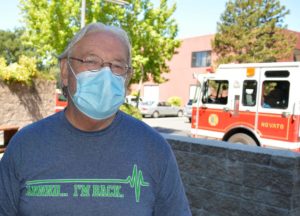
Ric gave a few remarks at the ceremony where he shared how much his family meant to him and told the paramedics how much he appreciated their lifesaving actions.
“I’ve always told my whole family how much I love them from the very start,” he said as he looked at the first responders. “And what you guys did is that you gave me another chance to tell them again how much I love them and how important to me they are. And you guys are my family also. I love every one of you. I appreciate you all very much.”
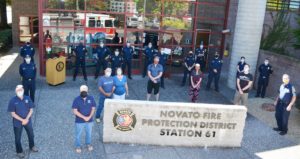
A year later, Ric, who previously restored antiques for dealers, continues to do well. He works on his garden every day.
As Ann reflects on her husband’s cardiac arrest, she said she was absolutely not ready for her husband to pass away. Ann, who is a former CPR instructor who received CPR training from AHA, said she wanted to try to do everything she could to ensure that he survived that day. She hopes others will feel compelled to also take action and start CPR if somebody they know or love suffers a cardiac emergency.
“The important thing that I want to pass along is to just try, “ she said. “Even if it’s scary or even if you don’t think you know how to do it, just try because you can make a difference.”
If you are called on to give CPR in an emergency, you will most likely be trying to save the life of someone you love: a child, a spouse, a parent or a friend. Hands-Only CPR has been shown to be as effective as conventional CPR for cardiac arrest at home, at work or in public. Learn the two easy steps of Hands-Only CPR by watching a short training video.
Bystander CPR helps save airport employee’s life

By Gina Mayfield
It was one of those mornings. Every parent knows the drill: You’re running behind, then a child decides he’s not on board with the usual morning routine, one thing leads to another and before you know it, you’re three hours late for work.
That was Patty Hill’s experience one hot August morning. Shortly after she finally arrived for her shift at Hartsfield-Jackson Atlanta International Airport, she stepped aside to take a phone call from her mother. Minutes into the call, Patty heard a cry for help. Then another. At that point, she quickly said to her mom, “I’m gonna call you right back,” and said to herself, Let me see what’s going on.
What was going on was the manager of the food court, Ms. V, as she’s affectionately known around ATL, was laid flat out on the ground. She had hit her head as she fell on the concourse and was completely unresponsive. At first it appeared as though a young woman was administering aid, but upon closer inspection, Patty realized that wasn’t quite the case.
“I looked at her as she was checking for a pulse … with her thumb,” Patty says. At that point, she knew she had to intervene. “I was like, uh-uh. I tapped her on the shoulder and said, ‘Step back, baby.’ Once I got down there and used my two fingers to find there was no pulse, I started chest compressions immediately.”
Because of airport security requirements, Patty had routinely carried a see-through bag to work, one that clearly displayed her bright orange resuscitation mask pack. A coworker had once jokingly asked her, “Why do you carry that?” Patty responded with her usual quick wit. “You never know, I might have to give you all mouth to mouth one day, and I ain’t putting my mouth on y’all,” she laughed.
As it turned out, the very same coworker who had questioned the contents of Patty’s purse happened to be standing feet away from Patty as she administered chest compressions. “Go get my purse,” she instructed between compressions. “Go get that orange thing out of my purse.”
Being at a busy airport full of passengers, it wasn’t long before a doctor and nurse came running over. The doctor used that orange mask to deliver breaths, while Patty and the nurse took turns delivering chest compressions.
Then the doctor turned to Patty and asked the million-dollar question: Do you know where to find the AED machine? As it turned out, Patty had been standing right next to it during that phone call with her mother.
Eventually Patty’s manager came looking for her. “I didn’t know you were gone saving a life!” she said to Patty. In fact, that’s exactly what she was doing — the paramedics showed up about 20 minutes later.
Soon after, Patty had a chance to catch up with Ms. V at the hospital where she was being treated for cardiac arrest. “I met her kids, I met her family, I prayed over her. She is good,” Patty says.
Then she reflected on her own experience. She had received her CPR certification while training to be a medical assistant, but worked nights at the airport while completing an unpaid internship. “When I graduated as a medical assistant, I was always asking myself what I was doing at the airport. It was for a reason. God had me there for that particular day, August 1, 2018. I will never forget that,” she says.
Today, Patty is an instructor who teaches American Heart Association curriculum to her community. “I never thought that I would be saving somebody at the airport. I never thought I would take those skills that I learned to help save someone,“ she says. “It’s good to know CPR. Even kids. I encourage kids to learn as well. I think everybody needs to learn.”
In the end, on that particular hot August morning, it turns out Patty wasn’t late at all. She was exactly where she was supposed to be, exactly when she was supposed to be there. “Now that I look at it, it was right place, right time,” Patty says. “Everything was right on time.”
Join a Nation of Heartsavers today at cpr.heart.org/heartsaver. #CPRwithHeart



